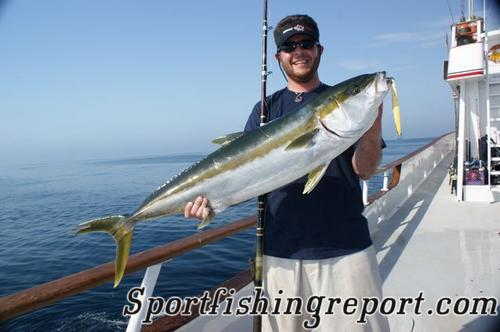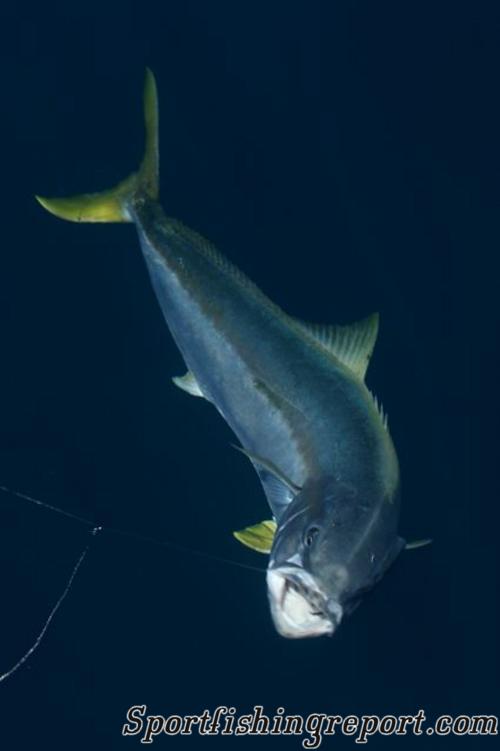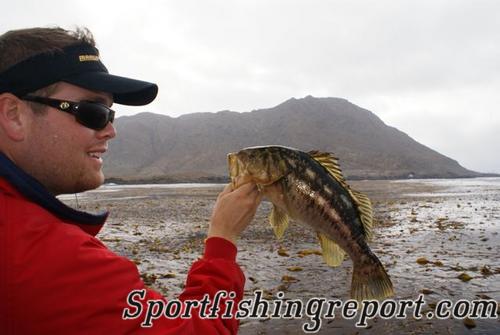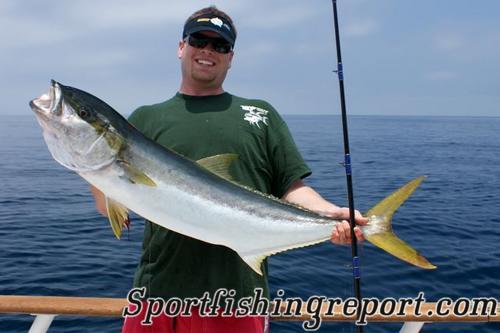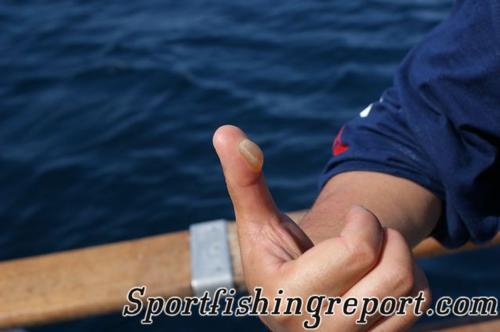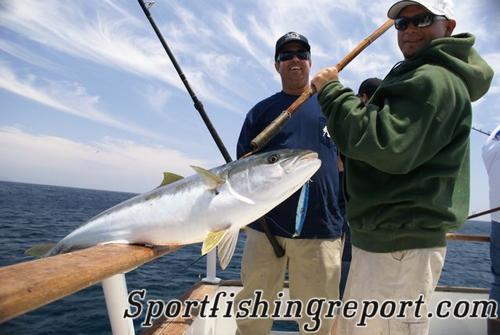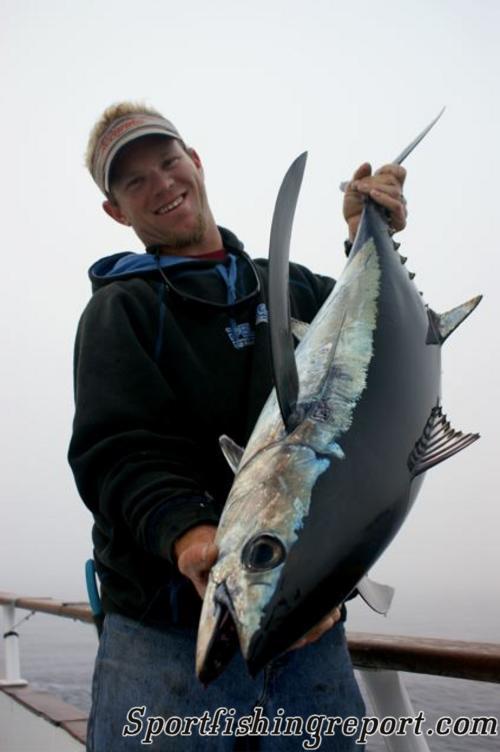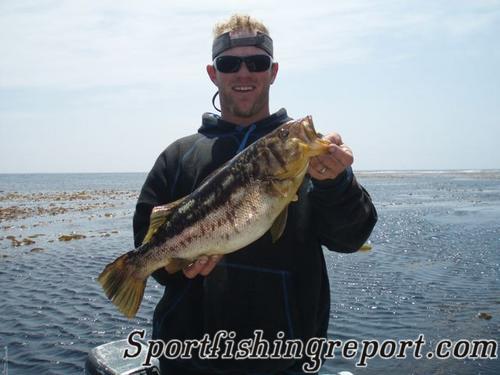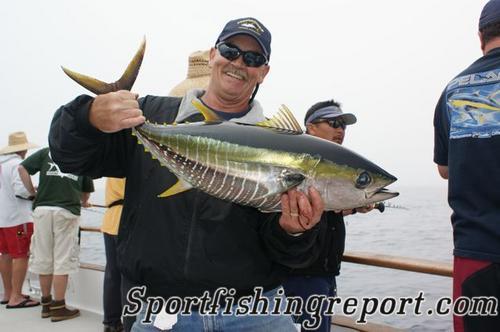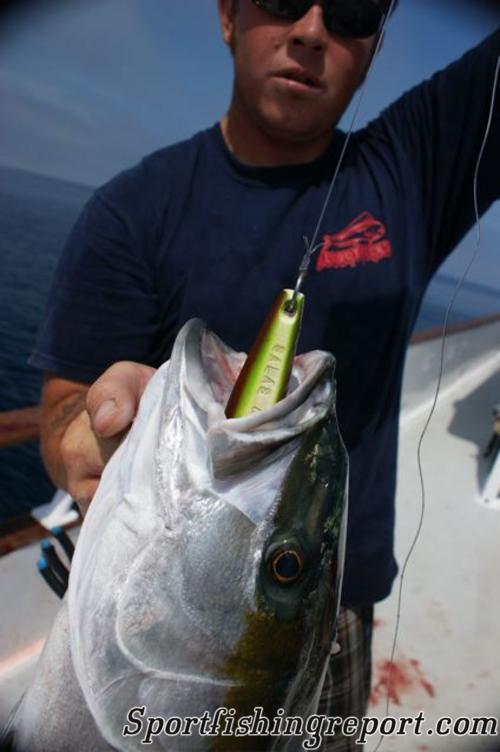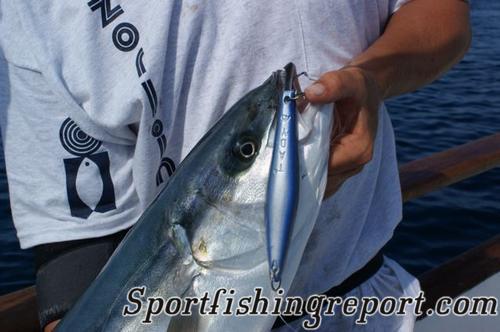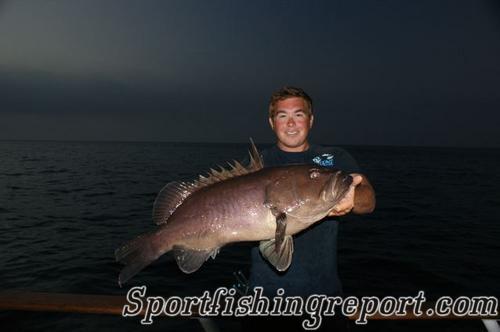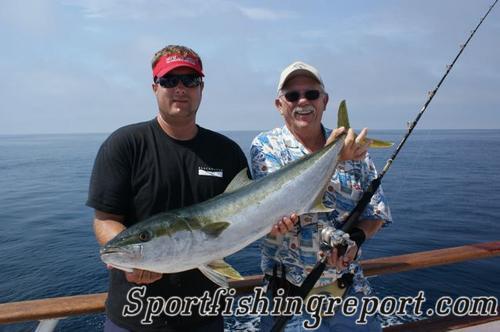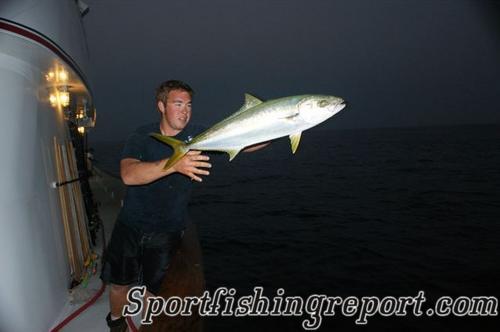Utah Fish Report
Fish Report for 6-30-2008
Fish Report for 6-30-2008
Yellowtail and Bass: It Doesn't Get Any Better
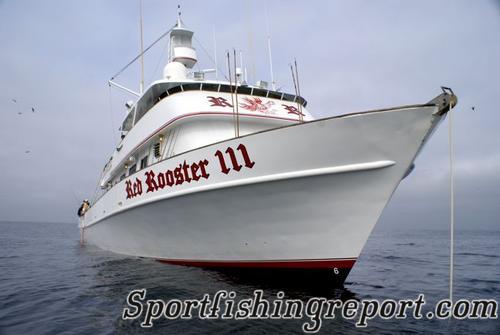
by Bill Roecker
6-30-2008
Website
Eight-day Thom Hultgen Memorial aboard Red Rooster III
Yellowtail And Bass: They Don't Bite Better Than This
Skipper Andy Cates eased the Red Rooster III out of her berth at H&M June 19 with 23 eager anglers aboard, and headed toward the bait receivers near the mouth of San Diego Bay. The Everingham Brothers supplied the 105-foot long ranger with all the sardines her tanks and slammers would hold, and Cates headed south, on the eight-day Thom Hultgen Memorial charter. Cameraman/graphics artist Paul Sweeney and I were there at the invitation of George Daniels, chartermaster and Hultgen's son.
The next day we reached the area where bluefin and albacore have been reported for several weeks. The place was easy to find, marked as it was by numerous seiners, many of them "pen boats" taking live fish to fatten. All appeared to be idle, waiting for something to happen. The first biters were small albacore. They rushed the boat and left shortly after tangling several bait fishermen in the upwind corner. Three or four found their way onto the Rooster.
"Microcore," observed one wag.
The next biters were bluefin. Dan Romo of Bakersfield, a trucker and dedicated angler, got one of the first two with a cedar plug.
"This thing's about 20 years old," he remarked.
"It looks like it," I said. "I like the natural finish myself."
Bob Novielli of Costa Mesa got the first bluefin on bait, using a sardine on a 3/0 ringed Mustad Hoodlum tied to 30-pound line on what he called "?Ķan old E-Glass Calstar. On his second run he went deep."
Alec Robbie, 15, of Santa Margarita plays deep safety and wrestles at Tesoro High. He got about all the wrestling he needed when he hooked a bluefin that later weighed over 32 pounds on 20-pound Mustad line and a ringed 94150 hook, the long-time standard. He used an outfit I lent him, with a 197 Accurate reel and a Seeker Black Steel 660 XF rod, coaxing the fish to gaff in some 25 minutes. No doubt his confidence was built, since he said he'd never caught a tuna on light tackle before.
Later that day Mike Reese of El Cajon got the first yellowfin of the trip, on a trolled Mexican Flag hexhead he said was either a Tady or Sumo jig. We spent that day trolling around the commercial fleet, picking up 10 bluefin, seven albacore and the one yellowfin. We looked in a couple of gullets to find many small mackerel, tiny squid and a few long-beaked, three-inch sauries or maybe snipefish.
Fishing like that wasn't going to cut it with skipper Cates, who spent the last 15 years or so proving he's one of the long range fleet's best tuna fishermen. On the same flat calm seas we'd been enjoying since we left San Diego, he called us into the galley that evening and said we were going to Cedros Island to check things out the next day.
We had a drawing that night, after every angler had received a bagful of goodies courtesy of FishingVideos.com's sponsors, and everyone got one more prize. Top winner was Danny Romo, who proved his luck hadn't run out by copping the Accurate 197 reel donated by Jack Nilsen. The sponsors were most generous, and deserve mention here: An appreciative thanks goes to AA's, Accurate, AFTCO, Cal's Two-Speed Reels, Catchy Tackle, Cofe Products, Fish Trap Lures, Flexx-Rap, Hayabusa, Izorline, Line One Spectra, Maxima, Mustad, Rod Knobie, Salas, Seaguar, Seeker Rods, Tady Lures, Yo-Zuri and Zucker's.
Two more drawings were held during the trip, and the fortunate anglers aboard wanted me to express their thanks, especially for the "dinner jigs"" served with each evening's meal; iron from Tady, Salas and Catchy Tackle, and new "Double Diamond" plastic swim baits from AA's and Tony Paino. Those plastics earned kudos later, at Augustine, the southwest point of Cedros Island. All the manufacturers offered items the anglers could use on this trip, things appropriate for fishing 20 to 50-pound gear. There may be no better way to acquaint anglers with useful products than on a long range trip. There's time to use the product, think about it and discuss it.
Our first visit to Cedros didn't pay off. We arrived in a cold fog, and found little biting in some ugly muddy green water. Ted Crane of Costa Mesa caught the first yellowtail, then a seal ate the second. Skipper Cates headed out for Clam Bay, which was sunny but just as ugly water-wise, and then took us down to San Pablo, where we saw numerous schools of small yellowtail. They seemed willing, but not large enough to warrant taking, in the eight to 15-pound class. Cates decided to try The Ridge.
The sea still flat calm, we rolled downhill all night, and around eight a.m. tried the 23 Spot. Nada. We tried the next couple of spots for no more. Cates was beginning to sweat bullets, wondering if we had made a two-day mistake. He talked with Randy Toussaint on the Royal Star, who was headed for Alijos Rocks. Well, that gave us one more southern option. We pushed on toward our last Ridge opportunity, Thetis Bank.
Numerous schools of bait marked the slick surface at Thetis, encouraging several Bloodydecks.com jig casters aboard to fire out the iron as we set up to anchor. Our chartermaster George Daniels connected with his brand new Catchy 22 jig in mint color, and soon decked a nice yellowtail of over 20 pounds. Then we got the hook down and settled in to what became two days of biting yellowtail, with the exception of an amberjack caught by Alec Robbie. The fish bit at all times except near sunset.
I cast out a sardine on 25-pound line, and it was grabbed before it could swim ten yards. Nursing a sprained wrist, I fumbled the fish in, a 22-pounder, and asked deckhand Tom Ferrari for a release. By now everyone was busy. Cook Steve Lamb was asking for anglers to come in for lunch, but drawing a blank at the tables. Steve did a great job of feeding us through the whole trip, but right now food couldn't compete with the fish. That bite lasted about five hours.
A few of the fish were only 12 to 15 pounds. The majority were 20 to 30 pounds, and a good number went up into the mid or high 30's. Fishing with 25-pound Mustad line and 94150 ringed hooks on a new Accurate 197 two-speed reel, I found I had a hard time lifting these fish once they went down. OK, let's try low gear. Wow! I could grind ???em up toward me like a bass! This was a fine test for my new Super Seeker 660 XF, too, and it performed flawlessly. I gave the injured wrist a break by going to the rail.
The fish were biting surface jigs, Salas 7X and Tady 45's, very well. They also bit sinking jigs, but few were fishing with those because the yellows were on live baits like flies on manure. I released a couple more, kept a couple of yellows that were badly hooked or large enough to dispatch without regret, and realized I needed to back off a notch on the pulling if I didn't want to re-injure myself. Since I'd spent the last three weeks getting better, I went to Jay.
Angler Jay Ho of Buena Park wasn't getting bit. He looked lonely, standing there with a straight rod in the midst of bent sticks. I got out a slightly heavier rig, a Super Seeker 6460 F rod and a new two-speed Accurate 870 N reel with 30-pound Seaguar fluorocarbon leader, 30-pound Izorline and 65-pound Line One Spectra backing. It only took a few seconds to make a yellowtail connection. I maneuvered next to Jay, handed him my rod and took his. He protested, but I was firm. He took the fish.
"Have you done this before?" I asked as he strained against the pull.
"This is the first time I've been out for more than one day," he said.
"Well, if you'll let me do it, I'll show you how to hook ???em," I told him.
By the time Jay got his first yellow to the boat he was grinning. It was a nice 25-pounder, and he put his number on it and took his old rod back. I hooked another fish within seconds, and we did the same, "you take it," gig and he gave up his stick, a little less reluctantly. So Jay and I settled into a long afternoon's lesson about nose-hooking baits, casting them and keeping the line tight while allowing the bait to swim, and reeling them back so it looked like they were swimming under their own power.
I hooked a fish for Jay on his rig, a seven-foot rod with an old 4/0 reel. He was surprised, but reeled it in.
"Why is this one so much easier?" he asked, the next time I passed him a fish on my rig.
"Because it's a narrow reel, and it doesn't torque over to the side so much when you grind on it," I told him. "And because it has a low gear, see?"
"Oh yeah," he said, grinding away at 2-1. "You want to sell this reel?"
"Not this one. I just got it."
After the basics, I helped Jay with the subtleties of bait fishing, how to tell the difference between a hot running bait and a take, where to throw the bait to get to the fish and avoid the other anglers, how to wind down to set the hook, how to judge if the bait was doing what it needed to do to provoke a bite. It takes years to learn these things, but Jay got a big head start in one afternoon, because the fish were hot to bite bait. I left Jay momentarily, and when I came back he was sporting a thumb-sized blister on the appendage.
"I tried to stop him with my thumb," he said.
"Another lesson learned," I replied.
Most anglers fished with 40 and 50-pound line, especially those plunging with torpedo sinkers and the hook on a loop above, and those throwing jigs with long rods.
But for small and medium-sized game fish, my feeling is that it's something less than sporting to use line tests that are heavier than the weight of the fish being caught.
Some skippers disagree with that opinion, especially if they're anxious to put fish on the boat or to prevent nimrods from sawing one another off. I'll just note that the Red Rooster III is 105 feet long, with enough room to allow two dozen anglers to fish a mild current on the anchor without stepping on one other.
There was a brief ceremony for Thom Hultgen at sunset, with two minutes of silence after Cates read off a list of names of departed anglers, including the recently deceased Jorge Nicifore, the Rooster's well-loved cook for decades. Corbett Paulen of Ocean Beach jigged up a big tan grouper after sunset. Everyone seemed to want to be in a picture with the beast. Peter J, who has a Newport Art Gallery, made a super Gyotaku print of the grouper, a "fish print" made by direct contact between fish and paper. Some odd-looking tropical bottom-dwellers, possibly rockfish, were also hoisted aboard.
Our second day of fishing on Thetis Bank was much like the first, except that we were ready to fish at dawn. Well, not all of us were ready. After the long day before, I slept in, showered and had breakfast before going on deck around seven.
"Boy, did you miss a wild bite," someone said. "There were big ones biting in the gray!"
Bait was king on Thetis Bank. On the slick calm water we could see breezers of scad in many places. Every few moments a big yellowtail would slash and swirl 50 yards from the boat, sometimes even closer. We viewed free-swimming yellowtail just off the stern rail frequently. The tropic sun burned off the haze early, and it got hot when there was no breeze. Even when there was a breeze it didn't ruffle the surface any more than the scad schools.
The morning bite lasted about six hours. It was possible most of that time to hook a yellowtail on surface iron. Seattle Boeing engineer Arvin Shajanian had a lot of fun with an ancient Lamiglas 12-footer, despite being teased about his "noodle."
Jerry Morris, a certified addictions counselor from Ontario said, "I didn't lose a jig the whole two days. The best one for me was the 7X in dorado color, but I also did well on the green sardine and blue and white."
Like several others, Jerry got his yellowtail limit fishing iron with a long rod.
After lunch we departed for Alijos Rocks, with a dawn ETA. On the way west through miles of 70-degree green water that afternoon we caught numerous small yellowfin of 10 to 15 pounds on jig stops. One school bit for several minutes. Most of those fish were released, but some were tagged.
Skipper Cates and second skipper Joe D'Acquisto were up in the wheelhouse, where I learned Joe had done some commercial tuna fishing. We spotted the dorsal and tail top of a swordfish and turned on it. We were close enough for a mackerel throw when it sank out, but no one tried. The body could be seen clearly until then. I saw a second swordfish minutes later. It went down when we slowed, right next to the boat, maybe a 200-pounder. The first one looked to be 300 pounds.
We got to the Rocks under gray skies and a light breeze out of the northwest building a northwest swell. Royal Star was coming back from Alijos Bank, where she's made a good catch of large yellowtail. Skipper Randy Toussaint told us he hadn't seen any good tuna, but a few small ones were around. After several hours of bait fishing and trolling around the drop-offs, we had to agree. We still had a shot at Cedros, skipper Cates thought, and if we left now we'd get there the next morning. He asked his group, and got unanimous approval.
That night we hit the only normal offshore weather of the trip, a four-foot swell with a two-foot chop. It wasn't rough enough to call it uncomfortable, but it was a real change from the lake we'd been sailing on.
Cedros Island still had a low ceiling, but the water had cleaned up nicely when we arrived at Augustine, on the Island's southwest point. It was a cool 64 degrees, and plenty of terns, gulls, cormorants and pelicans were fishing outside the kelp. The weeds were loaded with willing calico bass of one to nine pounds. Second skipper Joe D'Acquisto and deckhands Nick Maurer and Moses Milton took two anglers at a time in the ship's skiff to the very point at Augustine for hour-long bouts with the bass, until all who wished had a trip.
Those kelp bass were so accommodating it was almost sinful. They could be seen swimming in the watery foliage, said Moses, and they flashed out to lay teeth on the variety of plastic baits dropped into the holes in the weed. The new Double Diamonds were killer, the boys said. In truth, the bass were biting nails and anything else that they spotted encroaching their golden corridors.
The plastic baits had to be changed often as they became frazzled. Skipper Joe said his worst trip produced 12 bass, and the best one over 50. All were released.
"You'd hook one," said Joe, "and there'd be four or five calico bass right behind it, trying to get the bait."
While the bassing went on, the anglers on the stern amused themselves with more yellowtail. These fish were running close to 30 pounds on the average. I got one a little bigger than that up to the boat, and a sea lion grabbed it and took it out a hundred yards. He was too far to hear what I was saying, and by the way he treated the fish, probably didn't care. Moses got the carcass back, but it was unusable for anything but fertilizer; belly gone and the back meat shredded down both sides like machaca.
"Gosh," I said, or something like that.
We didn't really need many more yellows to limit out, so no one griped when the bite slacked after lunch. That was a shrimp and yellowtail meal, done with rice in Creole style by cook Steve Lamb. Steve and his assistant John Wise did a good job for us three times a day, and for dinners we enjoyed barbequed ribs with clam chowder, rack of lamb (no pun intended), New York Steak and wahoo. Lunches of fish and chips (with fresh yellowtail and Steve's family secret batter), pork tenderloin with cranberry sauce, and hefty cheeseburgers were also memorable. The food was good, classic American.
After everyone who wished went bassing in the skiff skipper Cates headed back out on calming seas for the albacore grounds. We got there at dawn the next day, and spent the rest of our fishing time driving around the drifting seiners, picking up some more albacore and a couple of yellowfin. One albie school bit for several minutes, but the rest of the trolling was hit and run.
The time came when we were out of time.
"Wind ???em up, guys," said skipper Andy over the p.a. system. "Break down your gear and stow it away, because we've got to get going. I want to make it in tomorrow morning at seven."
Cates pointed the Rooster's beak toward home.
Yellowtail And Bass: They Don't Bite Better Than This
Skipper Andy Cates eased the Red Rooster III out of her berth at H&M June 19 with 23 eager anglers aboard, and headed toward the bait receivers near the mouth of San Diego Bay. The Everingham Brothers supplied the 105-foot long ranger with all the sardines her tanks and slammers would hold, and Cates headed south, on the eight-day Thom Hultgen Memorial charter. Cameraman/graphics artist Paul Sweeney and I were there at the invitation of George Daniels, chartermaster and Hultgen's son.
The next day we reached the area where bluefin and albacore have been reported for several weeks. The place was easy to find, marked as it was by numerous seiners, many of them "pen boats" taking live fish to fatten. All appeared to be idle, waiting for something to happen. The first biters were small albacore. They rushed the boat and left shortly after tangling several bait fishermen in the upwind corner. Three or four found their way onto the Rooster.
"Microcore," observed one wag.
The next biters were bluefin. Dan Romo of Bakersfield, a trucker and dedicated angler, got one of the first two with a cedar plug.
"This thing's about 20 years old," he remarked.
"It looks like it," I said. "I like the natural finish myself."
Bob Novielli of Costa Mesa got the first bluefin on bait, using a sardine on a 3/0 ringed Mustad Hoodlum tied to 30-pound line on what he called "?Ķan old E-Glass Calstar. On his second run he went deep."
Alec Robbie, 15, of Santa Margarita plays deep safety and wrestles at Tesoro High. He got about all the wrestling he needed when he hooked a bluefin that later weighed over 32 pounds on 20-pound Mustad line and a ringed 94150 hook, the long-time standard. He used an outfit I lent him, with a 197 Accurate reel and a Seeker Black Steel 660 XF rod, coaxing the fish to gaff in some 25 minutes. No doubt his confidence was built, since he said he'd never caught a tuna on light tackle before.
Later that day Mike Reese of El Cajon got the first yellowfin of the trip, on a trolled Mexican Flag hexhead he said was either a Tady or Sumo jig. We spent that day trolling around the commercial fleet, picking up 10 bluefin, seven albacore and the one yellowfin. We looked in a couple of gullets to find many small mackerel, tiny squid and a few long-beaked, three-inch sauries or maybe snipefish.
Fishing like that wasn't going to cut it with skipper Cates, who spent the last 15 years or so proving he's one of the long range fleet's best tuna fishermen. On the same flat calm seas we'd been enjoying since we left San Diego, he called us into the galley that evening and said we were going to Cedros Island to check things out the next day.
We had a drawing that night, after every angler had received a bagful of goodies courtesy of FishingVideos.com's sponsors, and everyone got one more prize. Top winner was Danny Romo, who proved his luck hadn't run out by copping the Accurate 197 reel donated by Jack Nilsen. The sponsors were most generous, and deserve mention here: An appreciative thanks goes to AA's, Accurate, AFTCO, Cal's Two-Speed Reels, Catchy Tackle, Cofe Products, Fish Trap Lures, Flexx-Rap, Hayabusa, Izorline, Line One Spectra, Maxima, Mustad, Rod Knobie, Salas, Seaguar, Seeker Rods, Tady Lures, Yo-Zuri and Zucker's.
Two more drawings were held during the trip, and the fortunate anglers aboard wanted me to express their thanks, especially for the "dinner jigs"" served with each evening's meal; iron from Tady, Salas and Catchy Tackle, and new "Double Diamond" plastic swim baits from AA's and Tony Paino. Those plastics earned kudos later, at Augustine, the southwest point of Cedros Island. All the manufacturers offered items the anglers could use on this trip, things appropriate for fishing 20 to 50-pound gear. There may be no better way to acquaint anglers with useful products than on a long range trip. There's time to use the product, think about it and discuss it.
Our first visit to Cedros didn't pay off. We arrived in a cold fog, and found little biting in some ugly muddy green water. Ted Crane of Costa Mesa caught the first yellowtail, then a seal ate the second. Skipper Cates headed out for Clam Bay, which was sunny but just as ugly water-wise, and then took us down to San Pablo, where we saw numerous schools of small yellowtail. They seemed willing, but not large enough to warrant taking, in the eight to 15-pound class. Cates decided to try The Ridge.
The sea still flat calm, we rolled downhill all night, and around eight a.m. tried the 23 Spot. Nada. We tried the next couple of spots for no more. Cates was beginning to sweat bullets, wondering if we had made a two-day mistake. He talked with Randy Toussaint on the Royal Star, who was headed for Alijos Rocks. Well, that gave us one more southern option. We pushed on toward our last Ridge opportunity, Thetis Bank.
Numerous schools of bait marked the slick surface at Thetis, encouraging several Bloodydecks.com jig casters aboard to fire out the iron as we set up to anchor. Our chartermaster George Daniels connected with his brand new Catchy 22 jig in mint color, and soon decked a nice yellowtail of over 20 pounds. Then we got the hook down and settled in to what became two days of biting yellowtail, with the exception of an amberjack caught by Alec Robbie. The fish bit at all times except near sunset.
I cast out a sardine on 25-pound line, and it was grabbed before it could swim ten yards. Nursing a sprained wrist, I fumbled the fish in, a 22-pounder, and asked deckhand Tom Ferrari for a release. By now everyone was busy. Cook Steve Lamb was asking for anglers to come in for lunch, but drawing a blank at the tables. Steve did a great job of feeding us through the whole trip, but right now food couldn't compete with the fish. That bite lasted about five hours.
A few of the fish were only 12 to 15 pounds. The majority were 20 to 30 pounds, and a good number went up into the mid or high 30's. Fishing with 25-pound Mustad line and 94150 ringed hooks on a new Accurate 197 two-speed reel, I found I had a hard time lifting these fish once they went down. OK, let's try low gear. Wow! I could grind ???em up toward me like a bass! This was a fine test for my new Super Seeker 660 XF, too, and it performed flawlessly. I gave the injured wrist a break by going to the rail.
The fish were biting surface jigs, Salas 7X and Tady 45's, very well. They also bit sinking jigs, but few were fishing with those because the yellows were on live baits like flies on manure. I released a couple more, kept a couple of yellows that were badly hooked or large enough to dispatch without regret, and realized I needed to back off a notch on the pulling if I didn't want to re-injure myself. Since I'd spent the last three weeks getting better, I went to Jay.
Angler Jay Ho of Buena Park wasn't getting bit. He looked lonely, standing there with a straight rod in the midst of bent sticks. I got out a slightly heavier rig, a Super Seeker 6460 F rod and a new two-speed Accurate 870 N reel with 30-pound Seaguar fluorocarbon leader, 30-pound Izorline and 65-pound Line One Spectra backing. It only took a few seconds to make a yellowtail connection. I maneuvered next to Jay, handed him my rod and took his. He protested, but I was firm. He took the fish.
"Have you done this before?" I asked as he strained against the pull.
"This is the first time I've been out for more than one day," he said.
"Well, if you'll let me do it, I'll show you how to hook ???em," I told him.
By the time Jay got his first yellow to the boat he was grinning. It was a nice 25-pounder, and he put his number on it and took his old rod back. I hooked another fish within seconds, and we did the same, "you take it," gig and he gave up his stick, a little less reluctantly. So Jay and I settled into a long afternoon's lesson about nose-hooking baits, casting them and keeping the line tight while allowing the bait to swim, and reeling them back so it looked like they were swimming under their own power.
I hooked a fish for Jay on his rig, a seven-foot rod with an old 4/0 reel. He was surprised, but reeled it in.
"Why is this one so much easier?" he asked, the next time I passed him a fish on my rig.
"Because it's a narrow reel, and it doesn't torque over to the side so much when you grind on it," I told him. "And because it has a low gear, see?"
"Oh yeah," he said, grinding away at 2-1. "You want to sell this reel?"
"Not this one. I just got it."
After the basics, I helped Jay with the subtleties of bait fishing, how to tell the difference between a hot running bait and a take, where to throw the bait to get to the fish and avoid the other anglers, how to wind down to set the hook, how to judge if the bait was doing what it needed to do to provoke a bite. It takes years to learn these things, but Jay got a big head start in one afternoon, because the fish were hot to bite bait. I left Jay momentarily, and when I came back he was sporting a thumb-sized blister on the appendage.
"I tried to stop him with my thumb," he said.
"Another lesson learned," I replied.
Most anglers fished with 40 and 50-pound line, especially those plunging with torpedo sinkers and the hook on a loop above, and those throwing jigs with long rods.
But for small and medium-sized game fish, my feeling is that it's something less than sporting to use line tests that are heavier than the weight of the fish being caught.
Some skippers disagree with that opinion, especially if they're anxious to put fish on the boat or to prevent nimrods from sawing one another off. I'll just note that the Red Rooster III is 105 feet long, with enough room to allow two dozen anglers to fish a mild current on the anchor without stepping on one other.
There was a brief ceremony for Thom Hultgen at sunset, with two minutes of silence after Cates read off a list of names of departed anglers, including the recently deceased Jorge Nicifore, the Rooster's well-loved cook for decades. Corbett Paulen of Ocean Beach jigged up a big tan grouper after sunset. Everyone seemed to want to be in a picture with the beast. Peter J, who has a Newport Art Gallery, made a super Gyotaku print of the grouper, a "fish print" made by direct contact between fish and paper. Some odd-looking tropical bottom-dwellers, possibly rockfish, were also hoisted aboard.
Our second day of fishing on Thetis Bank was much like the first, except that we were ready to fish at dawn. Well, not all of us were ready. After the long day before, I slept in, showered and had breakfast before going on deck around seven.
"Boy, did you miss a wild bite," someone said. "There were big ones biting in the gray!"
Bait was king on Thetis Bank. On the slick calm water we could see breezers of scad in many places. Every few moments a big yellowtail would slash and swirl 50 yards from the boat, sometimes even closer. We viewed free-swimming yellowtail just off the stern rail frequently. The tropic sun burned off the haze early, and it got hot when there was no breeze. Even when there was a breeze it didn't ruffle the surface any more than the scad schools.
The morning bite lasted about six hours. It was possible most of that time to hook a yellowtail on surface iron. Seattle Boeing engineer Arvin Shajanian had a lot of fun with an ancient Lamiglas 12-footer, despite being teased about his "noodle."
Jerry Morris, a certified addictions counselor from Ontario said, "I didn't lose a jig the whole two days. The best one for me was the 7X in dorado color, but I also did well on the green sardine and blue and white."
Like several others, Jerry got his yellowtail limit fishing iron with a long rod.
After lunch we departed for Alijos Rocks, with a dawn ETA. On the way west through miles of 70-degree green water that afternoon we caught numerous small yellowfin of 10 to 15 pounds on jig stops. One school bit for several minutes. Most of those fish were released, but some were tagged.
Skipper Cates and second skipper Joe D'Acquisto were up in the wheelhouse, where I learned Joe had done some commercial tuna fishing. We spotted the dorsal and tail top of a swordfish and turned on it. We were close enough for a mackerel throw when it sank out, but no one tried. The body could be seen clearly until then. I saw a second swordfish minutes later. It went down when we slowed, right next to the boat, maybe a 200-pounder. The first one looked to be 300 pounds.
We got to the Rocks under gray skies and a light breeze out of the northwest building a northwest swell. Royal Star was coming back from Alijos Bank, where she's made a good catch of large yellowtail. Skipper Randy Toussaint told us he hadn't seen any good tuna, but a few small ones were around. After several hours of bait fishing and trolling around the drop-offs, we had to agree. We still had a shot at Cedros, skipper Cates thought, and if we left now we'd get there the next morning. He asked his group, and got unanimous approval.
That night we hit the only normal offshore weather of the trip, a four-foot swell with a two-foot chop. It wasn't rough enough to call it uncomfortable, but it was a real change from the lake we'd been sailing on.
Cedros Island still had a low ceiling, but the water had cleaned up nicely when we arrived at Augustine, on the Island's southwest point. It was a cool 64 degrees, and plenty of terns, gulls, cormorants and pelicans were fishing outside the kelp. The weeds were loaded with willing calico bass of one to nine pounds. Second skipper Joe D'Acquisto and deckhands Nick Maurer and Moses Milton took two anglers at a time in the ship's skiff to the very point at Augustine for hour-long bouts with the bass, until all who wished had a trip.
Those kelp bass were so accommodating it was almost sinful. They could be seen swimming in the watery foliage, said Moses, and they flashed out to lay teeth on the variety of plastic baits dropped into the holes in the weed. The new Double Diamonds were killer, the boys said. In truth, the bass were biting nails and anything else that they spotted encroaching their golden corridors.
The plastic baits had to be changed often as they became frazzled. Skipper Joe said his worst trip produced 12 bass, and the best one over 50. All were released.
"You'd hook one," said Joe, "and there'd be four or five calico bass right behind it, trying to get the bait."
While the bassing went on, the anglers on the stern amused themselves with more yellowtail. These fish were running close to 30 pounds on the average. I got one a little bigger than that up to the boat, and a sea lion grabbed it and took it out a hundred yards. He was too far to hear what I was saying, and by the way he treated the fish, probably didn't care. Moses got the carcass back, but it was unusable for anything but fertilizer; belly gone and the back meat shredded down both sides like machaca.
"Gosh," I said, or something like that.
We didn't really need many more yellows to limit out, so no one griped when the bite slacked after lunch. That was a shrimp and yellowtail meal, done with rice in Creole style by cook Steve Lamb. Steve and his assistant John Wise did a good job for us three times a day, and for dinners we enjoyed barbequed ribs with clam chowder, rack of lamb (no pun intended), New York Steak and wahoo. Lunches of fish and chips (with fresh yellowtail and Steve's family secret batter), pork tenderloin with cranberry sauce, and hefty cheeseburgers were also memorable. The food was good, classic American.
After everyone who wished went bassing in the skiff skipper Cates headed back out on calming seas for the albacore grounds. We got there at dawn the next day, and spent the rest of our fishing time driving around the drifting seiners, picking up some more albacore and a couple of yellowfin. One albie school bit for several minutes, but the rest of the trolling was hit and run.
The time came when we were out of time.
"Wind ???em up, guys," said skipper Andy over the p.a. system. "Break down your gear and stow it away, because we've got to get going. I want to make it in tomorrow morning at seven."
Cates pointed the Rooster's beak toward home.
Photos
More Reports
Fishing Videos Reports
for Saturday, June 28th, 2008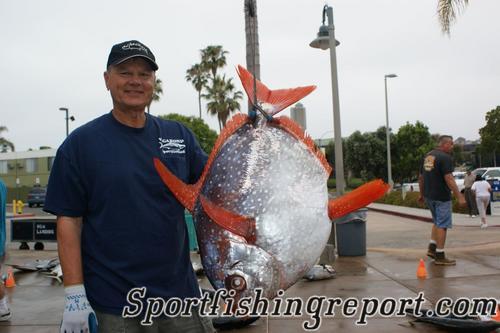
: The Big Bang!
: The Big Spread
: They Caught Everything
FishingVideos.com & the San Diego Sportfishing Council Sportfishing Report
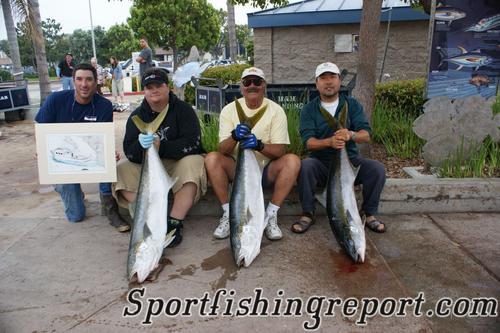
6-27-2008
Kids Limit On Yellowtail Bill Poole went along on the Allen Sackman Charter aboard the Excel with skipper Justin Fleck. The...... Read More

www.UtahFishReports.com © 2025. All Rights Reserved.
Website Hosting and Design provided by TECK.net
Website Hosting and Design provided by TECK.net

